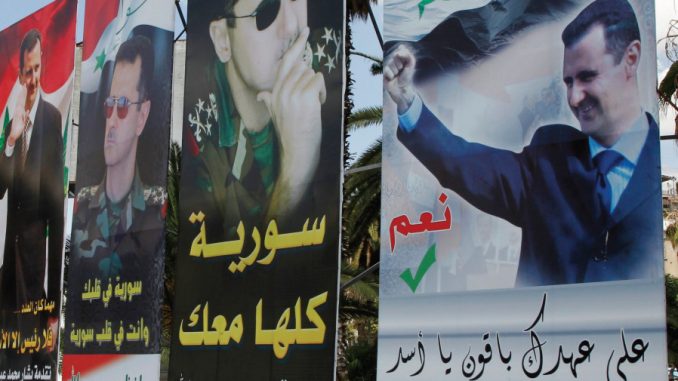Russia’s anticipated military withdrawal from Syria with the expected defeat of Islamic State (ISIS) will create a vacuum there that will be filled by Iran.
By Yonah Alexander, Milton Hoenig, JPOST

Make no mistake: the Iranian takeover of Syria happening “behind the scenes” is well underway. While the world’s attention is focused on North Korea, Tehran is practicing Sun Tzu’s geopolitical strategy that “all warfare is based on deception.” Iran’s prospects for extending its reckless and dangerous behavior in Syria urgently require a global response.
More specifically, Russia’s anticipated military withdrawal from Syria with the expected defeat of Islamic State (ISIS) will create a vacuum there that will be filled by Iran. Tehran and the Assad regime have long had continuous partner-like relations in many areas, including security cooperation.
Following the July 2017 agreement between the US and Russia on a ceasefire in southern Syria, Iran is now on the precipice of extending its influence throughout Syria in collaboration with Russia and with the support of Shi’ite rebel forces and Hezbollah reaching out from Lebanon.
To complicate matters, North Korea will undoubtedly play a role, but the extent can only be anticipated.
Already, there are signs of cooperation in Syria on potential WMD efforts that point to a direct connection between key military organizations in Pyongyang and Syria’s acquisition of conventional arms, chemical weapons and nuclear and ballistic missile technology.
For example, a confidential UN report in early August 2017 revealed that two shipments from North Korea in the previous six months were intercepted en route to a Syrian government agency with strong links to the military establishment, the Scientific Studies and Research Center (SSRC), under a contract with Pyongyang’s key arms exporter, the Korea Mining Development Trading Corporation (KOMID), that related to Syrian Scud missiles and the maintenance of Syrian air defense systems.
Furthermore, a decade earlier, on September 6, 2007, Israeli planes destroyed Syria’s suspected nuclear reactor at al-Kibar in the Deir ez-Zur region of northeastern Syria. This graphite-moderated reactor, like the one at Yongbyon in North Korea, was being constructed by North Korean workers and allegedly was designed to produce enough plutonium for one or two bombs annually.
Iran was also a player and reportedly channeled a billion dollars into the project with the plan to possibly use the reactor’s plutonium for weapons. Only later, in 2009, did an International Atomic Energy Agency (IAEA) report reveal that Syria had been suspected of seeking to buy “dual use” materials with North Korean support that could be used in a graphite reactor in producing plutonium for a nuclear program.
Thus, with Iran poised to gain full control and do as it pleases in Syria, it clearly would have many options to extend its WMD-related activities there.
Now that the 2015 Iran nuclear deal, the Joint Comprehensive Plan of Action (JCPOA ), with the US, Russia, Britain, France and Germany – has put a crimp in Iran’s nuclear activities, the international community should be alarmingly awake to the possibility, if not high probability, that Iran may try to move some forbidden nuclear weapons-related activities embargoed under the JCPOA to Syria, as well as pursuing advanced ballistic missile development there, in cooperation with North Korea.
Already Iran is reported to have built a missile factory in Syria.
Syria is a signatory of the Nuclear Nonproliferation Treaty (NPT) and as a non-weapons state is subject to IAEA safeguards on its nuclear activities to assure that they are only for peaceful purposes. But under Iran’s influence, that may not stop Syria from pursuing unacceptable nuclear activities clandestinely.
NPT membership did not stop Iran from pursuing a nuclear program of “Possible Military Dimensions,” as spelled out in a November 2011 IAEA report. Some of these PMD’s were halted by Iran before the end of 2003, but others, related to nuclear weapons design and delivery, were continued under less formal organization.
A selected group of nuclear weapons development activities are specifically banned in the 2015 JCPOA .
Would the ban on nuclear weapons development placed on Iran by provisions of the JCPOA and the restrictions on uranium enrichment cover activities carried out under Iranian direction in Syria in a cooperative arrangement? Moreover, Syria is not a party to the so-called Additional Protocol to its safeguards agreement with the IAEA that would allow IAEA inspectors to look into suspicious nuclear activities at any undeclared site.
Also, Iran’s control in Syria as a looming outcome of the July 2017 Russian-led cease-fire agreement is a threat to Israel, which is not simply sitting on the sidelines. Indeed, the latest Israeli air-strike, on September 7, 2017, targeted and heavily damaged a SSRC weapons factory in Masyaf in the Hama region of west-central Syria that develops precision guided rockets and missiles for the Syrian army and Hezbollah, as well as chemical weapons for the Assad regime.
Satellite images show that at least five major buildings at the facility were damaged in the strike. How the Israeli attack and threatened Syrian response affect Iranian intentions remains to be seen.
The outcome we describe – a potential Iranian takeover of Syria – is a scene of great concern. It demands a heightened awareness of the dangers of allowing Iran to take control of Syria in a joint venture with Syria’s President Bashar Assad. This is not only a matter of urgency for the US and Russia. It is one that should be placed immediately on the international agenda at the UN and elsewhere.
Yonah Alexander is the director of the Inter-University Center for Terrorism Studies and Senior Fellow at Potomac Institute for Policy Studies.
Milton Hoenig is a nuclear physicist and consultant.
They co-authored the books Super Terrorism: Biological, Chemical, and Nuclear and The New Iranian Leadership: Ahmadinejad, Terrorism, Nuclear Ambition, and the Middle East.



Putin must remember that he is an INFIDEL!!! Like a scorpion Iran will wait for her stink.